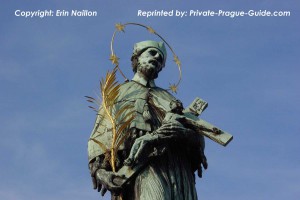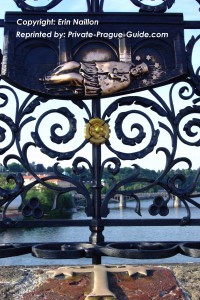John of Nepomuk
By Erin Naillon
Saint John of Nepomuk – the Legend
Saint John of Nepomuk is one of the top saints of the Czech Republic. The popular legend states that John was a confessor to the Queen of Bohemia and that he refused to reveal to the King what she told him in confession. The King, enraged, had John tortured and thrown from the Charles Bridge in chains.

John of Nepomuk – the Reality
John (Jan) Velflín was born in the small town of Pomuk, renamed Nepomuk, around the year 1345. He attended Charles University in Prague, then the University of Padua. In 1373, he took orders and became a public notary. Continuing his studies, he became a doctor of canon law in 1387. In 1393, Jan of Jenštejn, Archbishop of Prague, made John vicar-general.
John and Wenceslas IV
John was unlucky enough, or unwise enough, to fall afoul of King Wenceslas IV. This was the time of the Great Schism, and the King supported the Pope of Avignon. The Archbishop, however, was loyal to the Pope of Rome. The two men had locked horns over the appointment of a new abbot for the Abbey of Kladruby. The King wanted the abbey to be turned into a cathedral and had ordered that no new abbot be nominated after the death of the incumbent, Rarek. When Rarek died in 1393, the monks of the abbey promptly elected a successor, Odelenus. The less-important John confirmed the Archbishop’s candidate, and the King had him taken to Prague Castle for torture, with four other men involved in the appointment of the new abbot. The other four men recanted; John refused.
The Death of John of Nepomuk
The King himself took part in the torture of his victim. A mural on one of the interior walls of Prague Castle portrays John with a burning torch held to his side. When the King had had his fill of torture, John was taken to the Charles Bridge, bound in chains and with a piece of wood in his mouth, and thrown into the Vltava River. A cross marks the spot on the bridge where John was sent to his death. He died on March 20, 1393.

The Aftermath
Just after John’s execution, Jan of Jenštejn went quickly to Rome with the new abbot of Kladruby. As early as this date, Jan referred to John as “martyr sanctus”. It didn’t take long for the martyred clergyman to become revered as a saint. His body was recovered from the Vltava River and buried in St. Vitus’ Cathedral. Just a few years after John’s death, miracles were being attributed to him. It is said that five stars appeared above the water where John fell. Representations of him often show him with a halo of stars. As the cult grew, so did the belief that John had been murdered as a result of his refusal to reveal the Queen’s confession.
Saint John of Nepomuk
A statue of John – who had not yet been canonized – was placed on the Charles Bridge in 1683. Another of the legends surrounding the martyr is that his ghost wandered the bridge uneasily after his death. The statue, according to the legend, now contains his spirit. Two bronze plaques, well-polished by the hands of countless tourists, decorate the base of the statue. If you touch the plaques, your wish will come true, plus you will return to Prague.
In 1708, a church in Hradec Králové was dedicated to John of Nepomuk. Thirteen years later, on May 31, 1721, he was beatified; on March 19, 1729, he was canonized. His feast day is May 16.




